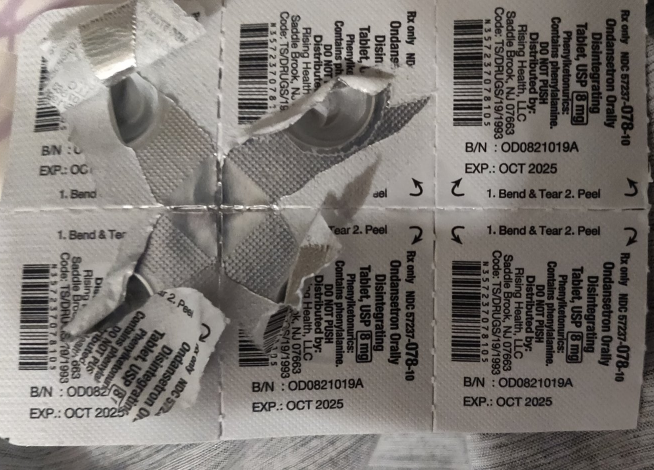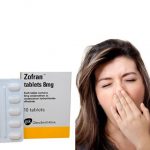How Long After Taking Zofran Can You Drink Water?

Many people have difficulty swallowing pills or tablets. Dry mouth, difficulty swallowing (dysphagia), and fear of choking can all make the act of taking prescribed medication feel next to impossible.
For these groups of people and others, an orally disintegrating tablet can be very beneficial because all they need to do is to place the tablet in their mouth and allow it to dissolve, then swallow or spit it out depending on the medication.
Orally disintegrating tablets also offer faster onset of action, better absorption, and improved bioavailability. This makes them attractive dosage formats for patients and manufacturers alike.
What is Zofran?
Zofran is a brand of ondansetron, a medication used to prevent nausea and vomiting caused by cancer chemotherapy, radiation therapy, or surgery. It is also effective for treating gastroenteritis. It can be given by mouth or by injection into a muscle or into a vein.
Zofran Orally Disintegrating Tablets (ODT) are bioequivalent to corresponding doses of Zofran Tablets. They are a freeze-dried, orally administered formulation of ondansetron that disintegrates on the tongue and does not require water to aid dissolution or swallowing. Ondansetron orally disintegrating tablet is also available as a generic drug.
How to use Zofran Orally Disintegrating Tablets (ODT)
This medication may be taken with or without food. However, your doctor may tell you not to eat before chemotherapy, radiation, or surgery.
Dosage is based on your medical condition and response to therapy. The dosage for children may also be based on age and weight. The usual maximum dose in patients with severe liver problems is 8 milligrams in 24 hours. Take this medication exactly as directed. Do not take more medication or take it more often than prescribed. Ask your doctor or pharmacist if you have questions.
Drug forms and strengths
Generic: Ondansetron
Form: orally disintegrating tablet
Strengths: 4 mg, 8 mg
Brand: Zofran ODT
Form: orally disintegrating tablet
Strengths: 4 mg, 8 mg
Dosage for prevention of nausea and vomiting caused by chemotherapy
Adult dosage (ages 18–64 years)
Typical dosage for chemotherapy that’s highly likely to cause nausea and vomiting: A single 24-mg dose given 30 minutes before chemotherapy.
Typical dosage for chemotherapy that’s somewhat likely to cause nausea and vomiting: 8 mg, 30 minutes before chemotherapy. Eight hours later, you can take another 8 mg. For 1–2 days after chemotherapy, you can take 8 mg twice per day.
Child dosage (ages 12–17 years)
Typical dosage for chemotherapy that’s somewhat likely to cause nausea and vomiting: 8 mg given 30 minutes before chemotherapy. Four and eight hours after the first dose, your child can take another 8 mg. For 1–2 days after chemotherapy, they can take 8 mg three times per day.
Child dosage (ages 4–11 years)
Typical dosage for chemotherapy that’s somewhat likely to cause nausea and vomiting: 4 mg given 30 minutes before chemotherapy. Four and eight hours after the first dose, your child can take another 4 mg. For 1–2 days after chemotherapy, your child can take 4 mg, three times per day.
Child dosage (ages 0–3 years)
It has not been confirmed that ondansetron is safe and effective for use in children younger than 4 years. It should not be used in children of this age range.
Senior dosage (ages 65 years and older)
The kidneys of older adults may not work as well as they used to. This can cause your body to process drugs more slowly. As a result, a higher amount of a drug stays in your body for a longer time. This raises your risk of side effects.
Your doctor may start you on a lowered dosage or a different dosing schedule. This can help keep levels of this drug from building up too much in your body.
Dosage for prevention of nausea and vomiting caused by radiation treatment
Adult dosage (ages 18–64 years)
Typical dosage: 8 mg starting 1–2 hours before radiation, followed by 8 mg doses every 8 hours after that first dose. Continue for 1 to 2 days after you complete radiation treatment. This dosage may vary depending on the type of radiation you receive.
Child dosage (ages 0–17 years)
It has not been established that this drug is safe and effective for this use in children.
Senior dosage (ages 65 years and older)
The kidneys of older adults may not work as well as they used to. This can cause your body to process drugs more slowly. As a result, a higher amount of a drug stays in your body for a longer time. This raises your risk of side effects.
Your doctor may start you on a lowered dosage or a different dosing schedule. This can help keep levels of this drug from building up too much in your body.
Dosage for prevention of nausea and vomiting caused by surgery
Adult dosage (ages 18–64 years)
Typical dosage: 16 mg one hour before you receive anesthesia for surgery.
Child dosage (ages 0–17 years)
It has not been established that this drug is safe and effective for this use in children.
Senior dosage (ages 65 years and older)
The kidneys of older adults may not work as well as they used to. This can cause your body to process drugs more slowly. As a result, a higher amount of a drug stays in your body for a longer time. This raises your risk of side effects.
Your doctor may start you on a lowered dosage or a different dosing schedule. This can help keep levels of this drug from building up too much in your body.
How long does it take for Zofran (ODT) to be absorbed?
The main mechanism for the absorption of Zofran (ODT) into oral mucosa is via passive diffusion into the lipoidal membrane. The absorption of the drug through the sublingual route is 3 to 10 times greater than the oral route and is only surpassed by hypodermic injection. Zofran (ODT) reaches maximum blood concentrations in about 2 hours. The effects start within 30 minutes and can last anywhere between 8 to 12 hours.
How Long After Taking Zofran (ODT) Can You Drink Water?
After taking Zofran (ODT) wait for at least 5 minutes before drinking water or any fluid to allow for maximum absorption of the medication by the body. Doctors also recommend that you avoid consuming water or any fluid for 5 minutes before taking orally disintegrating tablets.
Does Zofran (ODT) work if you swallow it?
No, Zofran (ODT) will not work effectively if you chew or swallow it. The medication should be dissolved on top of the tongue. It is not meant to be chewed or swallowed like other tablet forms.
How long after taking Zofran (ODT) can you eat?
You should wait for at least 30 minutes to 1 hour after taking Zofran (ODT) If you are taking the medication for nausea that occurs with meals, the orally disintegrating tablet or oral soluble film can be taken 15 minutes before meals.
Ondansetron can be taken with or without food. The first dose of ondansetron is usually taken before the start of your surgery, chemotherapy, or radiation treatment. Follow your doctor’s dosing instructions very carefully.
What are the side effects of Zofran (ODT)?
Side effects of Zofran (ODT) include:
• anxiety
• cold sensation
• constipation
• diarrhea
• dizziness
• elevated liver function test results
• fever
• gynecologic disorder
• headache
• injection-site pain
• malaise or fatigue
• numbness and tingling
• poor oxygenation
• severe itching
• urinary retention
Other side effects of Zofran (ODT) include:
Cardiac
• heart rate irregularities (including ventricular and supraventricular tachycardia, premature ventricular contractions, and atrial fibrillation)
• slow heart rate
• electrocardiographic alterations (including second-degree heart block, QT/QTc interval prolongation, and ST segment depression)
• palpitations
• fainting (rarely and predominantly with intravenous ondansetron)
• transient ECG changes including QT/QTc interval prolongation have been reported.
This is not a complete list of side effects and others may occur. Call your doctor for medical advice about side effects. You may report side effects to FDA at 1-800-FDA-1088.
What other drugs will affect Zofran(ODT)?
Zofran (ODT) can cause a serious heart problem, especially if you use certain medicines at the same time, including antibiotics, antidepressants, heart rhythm medicine, antipsychotic medicines, and medicines to treat cancer, malaria, HIV, or AIDS. Tell your doctor about all medicines you use, and those you start or stop using during your treatment.
Taking ondansetron while you are using certain other medicines can cause high levels of serotonin to build up in your body, a condition called “serotonin syndrome,” which can be fatal. Tell your doctor if you also use:
• medicine to treat depression;
• medicine to treat a psychiatric disorder;
• a narcotic (opioid) medication; or
• medicine to prevent nausea and vomiting.
This list is not complete and many other drugs can interact with Zofran (ODT). This includes prescription and over-the-counter medicines, vitamins, and herbal products. Give a list of all your medicines to any healthcare provider who treats you.





